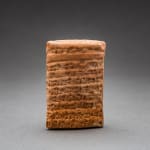Sumerian Cuneiform Tablet, 2034 BCE
5.2 x 7.8 cm
2 x 3 1/8 in
2 x 3 1/8 in
AM.0071
Further images
Sumerian cuneiform is one of the earliest known forms of written expression. First appearing in the 4th millennium BC in what is now Iraq, it was dubbed cuneiform (‘wedge-shaped’) because...
Sumerian cuneiform is one of the earliest known forms of written expression. First appearing in the 4th millennium BC in what is now Iraq, it was dubbed cuneiform (‘wedge-shaped’) because of the distinctive wedge form of the letters, created by pressing a reed stylus into wet clay. Early Sumerian writings were essentially pictograms, which became simplified in the early and mid 3rd millennium BC to a series of strokes, along with a commensurate reduction in the number of discrete signs used (from c.1500 to 600). The script system had a very long life and was used by the Sumerians as well as numerous later groups – notably the Assyrians, Elamites, Akkadians and Hittites – for around three thousand years. Certain signs and phonetic standards live on in modern languages of the Middle and Far East, but the writing system is essentially extinct. It was therefore cause for great excitement when the ‘code’ of ancient cuneiform was cracked by a group of English, French and German Assyriologists and philologists in the mid 19th century AD. This opened up a vital source of information about these ancient groups that could not have been obtained in any other way.
Cuneiform was used on monuments dedicated to heroic – and usually royal – individuals, but perhaps its most important function was that of record keeping. The palace-based society at Ur and other large urban centres was accompanied by a remarkably complex and multifaceted bureaucracy, which was run by professional administrators and a priestly class, all of whom were answerable to central court control. Most of what we know about the way the culture was run and administered comes from cuneiform tablets, which record the everyday running of the temple and palace complexes in minute detail, as in the present case. The Barakat Gallery has secured the services of Professor Lambert (University of Birmingham), a renowned expert in the decipherment and translation of cuneiform, to examine and process the information on these tablets. His scanned analysis is presented here. This document records the grant of arable, irrigated land to two individuals.
Professor Lambert’s translation is provided below:
Clay tablet, 78x52mm., with 19 lines of Sumerian cuneiform on obverse and reverse. An administrative document fom the period of the Third Dynasty of Ur, dated to the 4th year of Shu-Sin fourth king of the dynasty, c. 2034 B.C. It is a record of arable, irrigated land being assigned to two individuals: one iku to each person. The surface is rubbed in places so that reading is in parts difficult, and it is a very unusual formulation not fully so far understood.
Translation
1 iku: Basum, excluded from the tablet, son of Milala of the slave girls, mate Atanah, commoner
1 iku: Turam-ili, excluded from the tablet, son of Shu-Ninshubur, mate of Shu-ilishu, commoner: from Ibbi-Mu’ati and Ur- . . . , foreman
Shu-Amar-Sin, commoner made (?) the total account of the mates and commoners.
Puzur-Haya was . . . foreman: Nur-Sin took charge
Via Ur-Mes, governor
Month: Festival of Lis
Year: Shu-Sin, king of Ur, built the West Wall, “That which keeps the Tidnum at bay”.
It appears that the two men receiving land (for a season only) were at this point struck off the list of regulars, entitled every year to a plot of productive land. The men we have translated “commoners” were apparently men in the king’s service, who thereby forsook their civil rights.
Cuneiform was used on monuments dedicated to heroic – and usually royal – individuals, but perhaps its most important function was that of record keeping. The palace-based society at Ur and other large urban centres was accompanied by a remarkably complex and multifaceted bureaucracy, which was run by professional administrators and a priestly class, all of whom were answerable to central court control. Most of what we know about the way the culture was run and administered comes from cuneiform tablets, which record the everyday running of the temple and palace complexes in minute detail, as in the present case. The Barakat Gallery has secured the services of Professor Lambert (University of Birmingham), a renowned expert in the decipherment and translation of cuneiform, to examine and process the information on these tablets. His scanned analysis is presented here. This document records the grant of arable, irrigated land to two individuals.
Professor Lambert’s translation is provided below:
Clay tablet, 78x52mm., with 19 lines of Sumerian cuneiform on obverse and reverse. An administrative document fom the period of the Third Dynasty of Ur, dated to the 4th year of Shu-Sin fourth king of the dynasty, c. 2034 B.C. It is a record of arable, irrigated land being assigned to two individuals: one iku to each person. The surface is rubbed in places so that reading is in parts difficult, and it is a very unusual formulation not fully so far understood.
Translation
1 iku: Basum, excluded from the tablet, son of Milala of the slave girls, mate Atanah, commoner
1 iku: Turam-ili, excluded from the tablet, son of Shu-Ninshubur, mate of Shu-ilishu, commoner: from Ibbi-Mu’ati and Ur- . . . , foreman
Shu-Amar-Sin, commoner made (?) the total account of the mates and commoners.
Puzur-Haya was . . . foreman: Nur-Sin took charge
Via Ur-Mes, governor
Month: Festival of Lis
Year: Shu-Sin, king of Ur, built the West Wall, “That which keeps the Tidnum at bay”.
It appears that the two men receiving land (for a season only) were at this point struck off the list of regulars, entitled every year to a plot of productive land. The men we have translated “commoners” were apparently men in the king’s service, who thereby forsook their civil rights.





